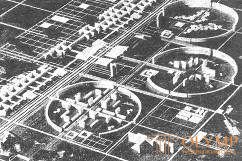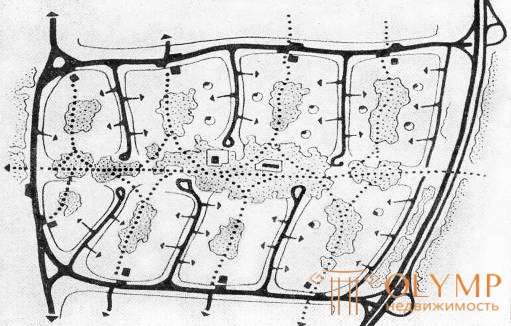
Definition: residential area - a zone for housing, community centers and recreation areas of the population, non-production environment of the population.
The main link in the structure of a residential area is residential formations formed within inter-trunk areas based on the functional and spatial unification of groups of residential buildings based on a joint service system (neighborhoods, neighborhoods).
Definition: the principle of microdivision is based on the integration of residential entities around the institutions of everyday services, the formation of a sustainable community of residents ("neighborhood"), the creation of a safe and comfortable living environment.
The principle of microzonation has been widely used in urban planning practice since the middle of the 20th century. At present, a significant part of the residential areas of large cities is represented by microdistricts (Fig. 84–87).
Transit traffic is excluded in the microdistrict, mainly pedestrian environment is formed.
Fig. 84. The project of the village Krasnoobsk, NSO, Layout. The residential area of the village consists of three microdistricts arranged around community center |
Fig. 85. A group of neighborhoods in Krasnoobsk, NSO, view from space |
Fig. 86. Microdistrict number 5, Novosibirsk, view from space |
Fig. 87. PDP residential area Kropotkinsky, NGP, 1973, arch. V. Blinkov, A. Bondarenko, V. Galyamov, B. Zherebyatiev, G. Tumanik |

Fig. 90. The ideal scheme of the neighborhood, Clarence Arthur Perry, 1929.
The planning decision of a neighborhood depends on a whole complex of factors:
the situation in the city, climatic conditions, relief and its orientation, socio-economic and demographic situation, etc.
The main goal of the planning organization of the neighborhood is to create a comfortable and safe living environment. This implies a number of tasks: the formation of an expressive image, the creation of a full-fledged service system, the breeding of pedestrian and transport traffic, the protection of yard spaces from noise, the landscaping of the territory, etc. (Fig. 103).

Fig. 103. The theoretical scheme of the planning organization of the microdistrict
In the neighborhoods provide a system of pedestrian paths, consisting of the main pedestrian roads and approaches to buildings. This system should connect residential groups with the shortest distances to public transport stops, public centers, car storage places and other objects of mass violence. The main pedestrian roads are trying to isolate from the streets and driveways (Fig. 104).
Что бы оставить комментарий войдите
Комментарии (0)